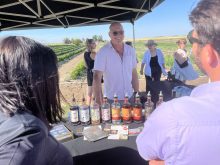WINNIPEG – How Manitoba farms can clean up the province’s water quality problem is an issue with more questions than answers, says a soil expert.
More prairie-based research is needed to test agricultural practices that have helped remove phosphorus in the United States, University of Manitoba professor Don Flaten said during the Manitoba Farm Women’s Conference Nov. 6.
He said farmers are not solely to blame for the overload of phosphorus in Lake Winnipeg that causes dead spots of low oxygen and algae bloom.
The problem is caused equally by agriculture, city sewage practices and Mother Nature.
Read Also

Vintage power on display at Saskatchewan tractor pull
At the Ag in Motion farm show held earlier this year near Langham, Sask., a vintage tractor pull event drew pretty significant crowds of show goers, who were mostly farmers.
And although the provincial government has now banned all new proposals for hog barns, Flaten said hog manure is only a small part of the problem. Intensive beef cattle operations are a bigger issue.
The public perceived hogs as a concern because they saw more barns built in the past decade, especially in Manitoba’s southeast, he said.
From 1991 to 2001, the province added 65 percent more animal units of hogs, compared to a 36 percent increase for beef. But 70 percent of the manure that is deposited on the land comes from cattle, not pigs.
Flaten said there must be a balance in the soil between phosphorus removed by plants and that added with fertilizer. He said 85 percent of the phosphorus added to Manitoba soil is commercial fertilizer; only 15 percent comes through manure.
Manitoba regulates manure application by basing it on nitrogen content rather than phosphorus, which can lead to build-up problems. If the province decides to regulate for phosphorus content, it “could have a big impact on your farm if you have livestock. You could be prohibited or limited in spreading manure,” Flaten said.
The Manitoba government’s main concern has been with phosphorus in the water, especially Lake Winnipeg. But Flaten said the city of Winnipeg adds phosphorus to its drinking water to coat lead water pipes but doesn’t remove it in its sewage treatment.
Pointing to water jugs on the conference tables, Flaten said there was more phosphorus content in that water “than coming off of 90 percent of agricultural land.”
















